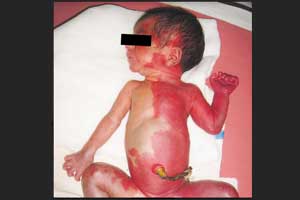- Home
- Editorial
- News
- Practice Guidelines
- Anesthesiology Guidelines
- Cancer Guidelines
- Cardiac Sciences Guidelines
- Critical Care Guidelines
- Dentistry Guidelines
- Dermatology Guidelines
- Diabetes and Endo Guidelines
- Diagnostics Guidelines
- ENT Guidelines
- Featured Practice Guidelines
- Gastroenterology Guidelines
- Geriatrics Guidelines
- Medicine Guidelines
- Nephrology Guidelines
- Neurosciences Guidelines
- Obs and Gynae Guidelines
- Ophthalmology Guidelines
- Orthopaedics Guidelines
- Paediatrics Guidelines
- Psychiatry Guidelines
- Pulmonology Guidelines
- Radiology Guidelines
- Surgery Guidelines
- Urology Guidelines
A Half-Red Baby: NEJM case report

A case of a Half-Red Baby has been reported in NEJM by Bethou Adhisivam at Jawaharlal Institute of Postgraduate Medical Education and Research, Pondicherry, India, and colleagues, the case history of which is as follows-
A 4-day-old, full-term, healthy female infant underwent a change in skin color from normal to red over one half of her body. The change in color, which persisted for a week, was consistent with harlequin color change — the development of redness on the dependent side of the body, with simultaneous blanching of the contralateral side.
Usually, this benign change in color is abrupt. Each episode tends to last between 30 seconds and 20 minutes and to resolve with increased activity. Up to 10% of infants undergo this color change, which occurs between the second and fifth days of life.
The shifts in color usually clear up completely within 3 weeks. Harlequin color change is thought to be caused by aberrant dilatation of the peripheral vasculature, possibly as a result of incomplete development of the hypothalamus.
Typically the color of our skin, eyes, and hair is controlled by special cells called melanocytes, which produce two types of a natural pigment called - melanins. Typical hues of skin are due to "eumelanin" — conveniently pronounced "you" + "melanin" — which is black-brown. Higher levels of eumelanin equal darker skin tones. Pheomelanin is a reddish-pink pigment that is most commonly found in red hair, but also in the lips, nipples, penis, and vagina.
The baby turned half-red, due to a rare condition called harlequin color change. Affecting about 10 percent of healthy newborns, the condition comes and goes, usually after a child was lying on its side, and can persist for up to three weeks. Each episode lasts from 30 seconds to 20 minutes and isn't thought to be harmful.
The leading theory is that vasodilation — widening of arteries and veins — allows extra red blood cell to travel into the vessels of the skin, causing discoloration.
The case is published in The New England Journal of Medicine.
For more details click on the link: DOI: 10.1056/NEJMicm1204130

Disclaimer: This site is primarily intended for healthcare professionals. Any content/information on this website does not replace the advice of medical and/or health professionals and should not be construed as medical/diagnostic advice/endorsement or prescription. Use of this site is subject to our terms of use, privacy policy, advertisement policy. © 2020 Minerva Medical Treatment Pvt Ltd